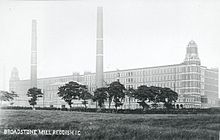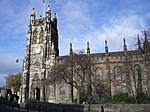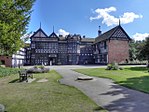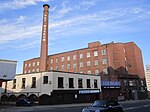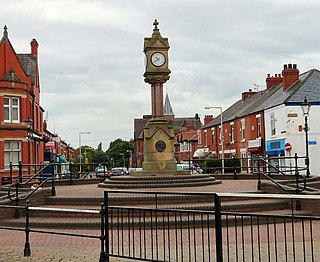
Reddish is an area in Metropolitan Borough of Stockport, Greater Manchester, England. 4.6 miles (7.4 km) south-east of Manchester city centre. At the 2011 census, the population was 28,052. Historically part of Lancashire, Reddish grew rapidly in the Industrial Revolution and still retains landmarks from that period, such as Houldsworth Mill, a former textile mill.

A cotton mill is a building that houses spinning or weaving machinery for the production of yarn or cloth from cotton, an important product during the Industrial Revolution in the development of the factory system.
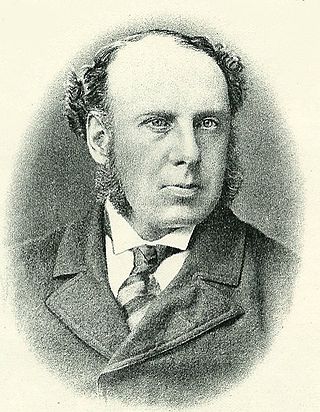
Sir William Henry Houldsworth, 1st Baronet was a British mill-owner in Reddish, Lancashire. He was Conservative MP for Manchester North West from 1883 to 1906, and sometime chairman of the Fine Cotton Spinners' Association. He was made a baronet in 1887.

The Hat Works is a museum in Stockport, Greater Manchester, England, which opened in 2000. Before that, smaller displays of hatting equipment were exhibited in Stockport Museum and in the former Battersby hat factory.
There is evidence of activity around Reddish – a settlement in Greater Manchester, England – before the Norman conquest in the presence of Nico Ditch and some Saxon coins. The recorded history of Reddish begins at the turn of the 13th century when it was documented as "Redich". Reddish remained a predominantly rural settlement throughout the medieval period, but expanded to become a mixed industrial and residential area during the 19th century. It developed rapidly during the Industrial Revolution, and still retains landmarks from that period, such as Houldsworth Mill.

Houldsworth Mill, also known as Reddish Mill, is a former mill in Reddish, Stockport, Greater Manchester, England. Designed by Abraham Stott, it was constructed in 1865 for Henry Houldsworth, a prominent mill owner at the time. It is a Grade II* listed building.

Regent Mill, Failsworth is a Grade II listed former cotton spinning mill in Failsworth, Oldham, Greater Manchester, England. It was built by the Regent Mill Co Ltd. in 1905, and purchased by the Lancashire Cotton Corporation in 1930. It was taken over by the Courtaulds Group in 1964. On ceasing textile production it was occupied by Pifco Ltd, and then by Salton Europe Ltd who now occupy this site. It was driven by an 1800 hp twin tandem compound engine by Buckley & Taylor. It became a ring mill with 60,000 spindles in 1915, all provided by Platt Brothers.

Minerva Mill was a cotton spinning mill in Ashton-under-Lyne, Greater Manchester, England. It was built between 1891 and 1892 for the Minerva Spinning Company which was later known as the Ashton Syndicate. Minerva Mill was next to the later Texas mill, at Whitelands. It ceased spinning cotton in the 1920s and was demolished in 1937.

Rock Mill was cotton spinning mill in the Waterloo district of Ashton-under-Lyne, Greater Manchester, in England. It was built between 1891 and 1893 for the Ashton Syndicate by Sydney Stott of Oldham. Rock Mill was built on the site of Wilshaw Mill retaining and using the octagonal chimney. It ceased spinning cotton in the 1960s and was demolished in 1971; the site became the location for the town's first Asda supermarket, which opened in 1972, until Asda relocated to a much larger new store site in Cavendish Street in 1989.

Cavendish Mill is a Grade II* listed former cotton spinning mill in Ashton-under-Lyne, Greater Manchester, in the United Kingdom. It was built between 1884 and 1885 for the Cavendish Spinning Company by Potts, Pickup & Dixon of Oldham. Cavendish Mill was next to the Ashton Canal Warehouse at Portland Basin. It ceased spinning cotton in 1934 and was then used for a variety of purposes before it was converted into housing in 1994.

Kingston Mill, Stockport is a mid nineteenth century cotton spinning mill in Edgeley, Stockport, Greater Manchester, England. It was taken over by the Lancashire Cotton Corporation in the 1930s and passed to Courtaulds in 1964. Production finished, it was made over to multiple uses.

Stott and Sons was an architectural practice in Lancashire between 1847 and 1931. It specialised in cotton mills, designing 191 buildings of which 130 were mills or buildings related to the cotton industry. Abraham Henthorn Stott was born on 25 April 1822 in the parish of Crompton. He served a seven-year apprenticeship with Sir Charles Barry, the architect of the Houses of Parliament and Manchester Art Gallery. Abraham returned to Oldham in 1847 and founded the architectural practice of A H Stott. It was known for his innovative structural engineering. His brother Joseph Stott in 1866 started his career here before leaving to start his own practice. Three of his nine children worked in the practice. Jesse Ainsworth Stott became the senior partner. Philip Sydney Stott spent three years in the practice before starting his own. After Abraham's retirement his practice was renamed Stott and Sons.
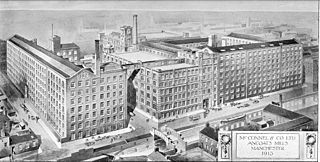
McConnel & Kennedy Mills are a group of cotton mills on Redhill Street in Ancoats, Manchester, England. With the adjoining Murrays' Mills, they form a nationally important group.

Ellenroad Mill was a cotton spinning mill in Newhey, a village in the Milnrow area of Rochdale, England. It was built as a mule spinning mill in 1890 by Stott and Sons and extended in 1899. It was destroyed by fire on 19 January 1916. When it was rebuilt, it was designed and equipped as a ring spinning mill.

Pear New Mill is a former Edwardian cotton spinning mill on the northern bank of the River Goyt in Bredbury, Stockport, Greater Manchester, England. It is a Grade II* listed building.

Clarence Mill is a five-storey former cotton spinning mill in Bollington, Cheshire, in England. It was built between 1834 and 1877 for the Swindells family of Bollington. It was built alongside the Macclesfield Canal, which opened in 1831.
Barnfield Mills was a complex of cotton mills that operated in Tyldesley, Greater Manchester, England from the middle of the 19th century.

Swan Lane Mills is a former cotton mill complex in Bolton, Greater Manchester. All three mills are Grade II* listed buildings. The mills were designed by Stott and Sons of Oldham. When completed, the double mill was the largest spinning mill in the world. It was granted Grade II* listed status on 26 April 1974. Number 3 Mill was separately listed as Grade II* on the same day.

Wear Mill was an integrated cotton works on the Cheadle Heath bank of the River Mersey in Stockport, Greater Manchester, in England. It was started around 1790 and added to, particularly in 1831 and 1884. In 1840, the Stockport Viaduct was built over the river and over Wear Mill.

Tower Mill is a cotton mill in Dukinfield, Greater Manchester, England. It is a grade II listed building. It was designed by Potts, Pickup & Dixon in 1885 and spun cotton, using mules and spinning frames until 1955 when it was no longer used as a cotton mill and was subsequently used by various industries and divided into small units, at one point plans were even passed for the mill to be converted into luxury apartments but with the recession in 2007/8 this plan was abandoned. After several years of lying empty it was eventually bought in 2013, restored and re-equipped to ring spin superfine cotton yarns in 2016 and is now after the absence for many years the only cotton mill in production in the United Kingdom.


